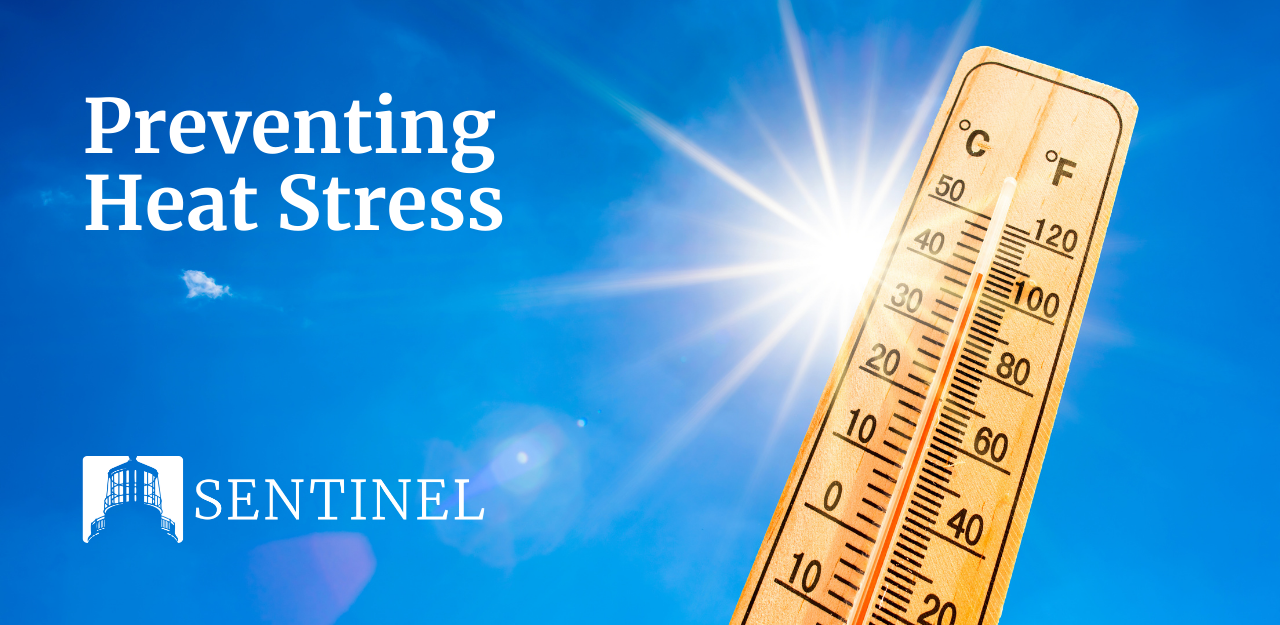As the summer heat rolls on and record temperatures continue to be set, safety-minded individuals start thinking about Heat Stress. Exposure to extreme heat can result in occupational illness and injuries including heat stroke, heat exhaustion, heat cramps, and heat rashes.
Employees who are exposed to extreme heat, both indoor and outdoor, should take extra precautions to help prevent heat stress in the summer months. If you are working in conditions that produce a lot of heat such as factories, warehouses, landscaping, utility/construction, public services, or package delivery, make sure you are taking appropriate steps to prevent the risk of heat stress.
Drink Plenty of Water
Heat stress occurs when the body cannot get rid of excess heat. When this happens, the body’s core temperature rises, and the heart rate increases. When the body continues to store heat, the individual can begin to display symptoms including loss of concentration and difficulty focusing, irritability or physical sickness, and fainting. Heat stress can even lead to death in extreme cases.
When employees are busy and focus on the immediate tasks at hand, they tend to not drink enough water throughout the day, which is especially dangerous in these hot and humid conditions. Water is one of the most abundant resources on earth, covering 71% of the earth (not all of it is drinkable of course).
For those who enjoy number crunching, there’s about 326 million – trillion gallons of water on Earth, so there is plenty of it to go around. If you need a visual on exactly how much water that is…. think lots of zeroes – 18 to be exact (326,000,000,000,000,000,000 gallons). Trying to understand that amount of anything can be mind-numbing, but our primary focus of this safety alert is to concentrate on the fact that we need to consistently provide our bodies with nature’s most precious and abundant element.
The OSHA Initiative
Within the past year, the Occupational Safety and Health Administration (OSHA) has initiated enhanced measures to better protect workers from hot environments and are working to increase awareness to the dangers of ambient heat. The OSHA initiative applies to indoor and outdoor worksites in general industry, construction, agriculture, and maritime where potential heat-related hazards exist.
On days when a recognized heat temperature can result in increased risk of heat-related illness, OSHA increases enforcement efforts. Employers are encouraged to implement intervention methods on heat priority days proactively, including regular water breaks and rest periods, the addition of shade in outdoor working areas, and performance of periodic measurements to determine workers’ overall heat exposure. Furthermore, they strive to train workers on how to identify common symptoms, and, more importantly, what to do when a worker suspects a heat-related illness is occurring. (source osha.gov).
Be Pro-Active
In extreme working conditions, sometimes your body’s natural cooling system simply is not enough. The best defense is a good offense – use common sense and be pro-active. This can include wearing loose, light-colored clothing and a breathable hat. Do not rely on others as to the weather forecast, take the initiative to familiarize yourself with weather trends.
If performing strenuous tasks, be mindful of your physical limitations, as everyone has different levels of conditioning. Do not forget to take breaks and find shade whenever possible. A best practice is to drink plenty of water, even if you don’t feel thirsty—consume at least 8 ounces of water every 20 to 30 minutes while working in the heat. If you do feel like you are getting overheated, seek shade while resting and be sure to notify a co-worker to help you evaluate any additional medical care you may need.
NIOSH 's Best Practices
In addition to the information above, The National Institute for Occupational Safety and Health (NIOSH) provides a great reminder for what employers can do to help control heat stress:
Engineering controls include:
- Increase air velocity
- Use reflective or heat-absorbing shielding or barriers
- Reduce steam leaks, wet floors, or humidity
Work practice recommendations include:
- Limit time in the heat and/or increase recovery time spent in a cool environment
- Increase the number of workers per task
- Train supervisors and workers about heat stress
- Implement a buddy system where workers observe each other
- Require workers to conduct self-monitoring and create a work group
- Provide adequate amounts of cool, potable water near the work area
- Encourage workers to drink frequently
- Implement a heat alert program whenever the weather service forecasts that a heat wave is likely to occur
Safeguarding Your Success
In closing, be mindful of the conditions that you are working in and around as well as look out for your co-workers. Take simple steps to prepare for the day’s work ahead and continue to provide your body with the hydration it needs while working in the heat.
Please contact Dana Vorholt, Sentinel’s Director of Risk Engineering, with any questions and be sure to visit the Sentinel Risk Performance Group website for additional resources.


